Mon 15 Mar 2021
A Book! Movie!! Movie!!! Movie!!!! Review by Dan Stumpf: DASHIELL HAMMETT – The Glass Key // THE GLASS KEY (1935) // THE GLASS KEY (1942) // MILLER’S CROSSING (1990).
Posted by Steve under Crime Films , Pulp Fiction , Reviews[5] Comments
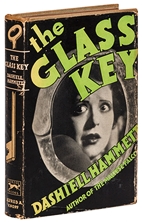
â— DASHIELL HAMMETT – The Glass Key. Alfred A. Knopf, hardcover, 1931. First published as a series of four connected novelettes in Black Mask magazine, March through June 1930.
◠THE GLASS KEY. Paramount, 1935. George Raft, Claire Dodd, Rosalind Keith, Edward Arnold, Guinn “Big Boy†Williams, Ray Milland and Tammany Young. Screenplay by Kathryn Scola, Kibec Glasmon, and Harry Ruskin. Directed by Frank Tuttle.
â— THE GLASS KEY. Paramount, 1942. Alan Ladd, Veronica Lake, Brian Donlevy, Bonita Granville, William Bendix, Joseph Calliea and Donald MacBride. Screenplay by Jonathan Latimer. Directed by Stuart Heisler.
◠MILLER’S CROSSING. Fox, 1990. Albert Finney, Gabriel Byrne, Marcia Gay Harden, John Turturro, Jon Polito, J.E. Freeman, Steve Buscemi, Sam Raimi and Frances McDormand. Written & directed by Joel & Ethan Coen.
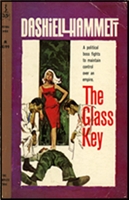
“Hammett gave murder back to the kind of people that commit it for reasons, not just to provide a corpse; and with the means at hand, not hand-wrought dueling pistols, curare and tropical fish.â€
In its short arc, Dashiell Hammett’s fiction went from mysteries to mystery novels, and he seems (to me anyway) to have been on the brink of an actual novel-novel when he went to Hollywood and Hellman and burned himself out. Whatever the case, THE GLASS KEY is balanced nicely between the Mysteries (RED HARVEST, THE DAIN CURSE, THE MALTESE FALCON) and the near-novel that was THE THIN MAN.
Set in some patently corrupt and nameless city, this is RED HARVEST writ for grown-ups, with gambler Ned Beaumont (Described as slim, mustached, well-dressed, hard-drinking — Hammett day-dreaming in the 3rd person) trying to protect the interests of his buddy, political boss Paul Madvig, and shield him from his own disastrous infatuation with a senator’s daughter, ambitious rivals, and from from taking the rap for a murder he may –or maybe not — have committed.
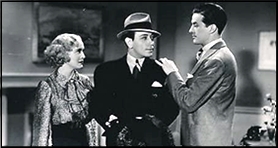
Hammett is just as passionate a writer as Woolrich, but he holds his feelings close to the vest, like a card-player with an iffy hand. The strength of Beaumont’s personal honor, and his love for a friend, comes out in action, like the understated effort he takes to collect a gambling debt, and most memorably in the prolonged beating he endures at the hands of sadistic henchman Jeff, to protect Madvig.
It’s a lengthy scene that becomes the emotional center of the book and lends a sense of uneasy tension to all the subsequent scenes where Jeff appears. Hammett sets up his characters nicely, then plays off our expectations like a real pro, and this finds him at the top of his game or pretty close to it.
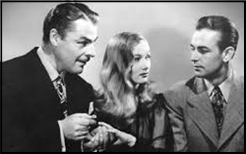
Paramount filmed it twice, first in 1935, then again in ’42. I really want to prefer the earlier version; it has a rough-and-ready pace, some expressive photography, and George Raft is just as inexpressive as Alan Ladd, with a veneer of slickness that suits the character well. There’s a particularly fine moment where he watches a brutal murder without a flicker of emotion. Director Frank Tuttle keeps the camera on Raft, his face lit by a wildly swinging overhead light that slows as a life slowly ebbs away. But the later version boasts a screenplay adaptation superior in most respects, and overall better casting.
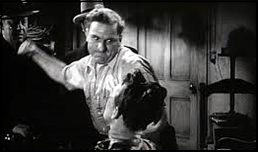
Foremost is Joseph Calliea as Nick Varno (Shad O’Rory in the book and the ’35 film) the gangster angling to supplant Brian Donlevy’s political boss. Calliea projects an icy authority that completely outclasses tepid Robert Gleckler in the earlier film. When Calliea snarls “You talk too much with your mouth, Jeff,†to William Bendix, you feel it in your bones.
Bendix plays Jeff, the sadistic, sub-normal goon who delights in beating up Alan Ladd, and he conveys all the coiled-spring tension of the character in the book—much better so than Guinn Williams in the ’36 version, who seems just too downright neighborly for the job.
As for Ladd and Lake, they make the unlikely attraction between the gambler and the society dame believable by dint of type-casting, if nothing else.
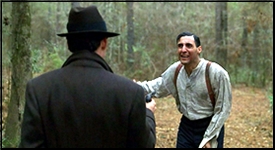
There’s a phrase in Hammett’s book, “little Miss Jesus,†that reappears in the movie MILLER’S CROSSING, but that’s not the only similarity in a film that features Gabriel Byrne as an unlucky gambler and hanger-on to political boss Albert Finney, who has unwisely antagonized gangster Sol Polito and Polito’s psychotic torpedo J.E. Freeman, all for the love of a woman who is playing him.
MILLER’S CROSSING emerges as a loving homage to THE GLASS KEY, with all the beatings, gang wars, double-dealings and understated feeling of the book, evoked by apt casting (John Turturro’s scheming chiseler is memorably drawn.) and a real feel for atmosphere and action.
And as if that weren’t enough, there’s a fleeting glimpse of a fight poster featuring “DROP JOHNSON vs LARS THORWALD.â€
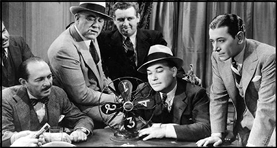
March 16th, 2021 at 8:40 am
The pairing of Alan Ladd and Veronica Lake (their second) was a match made in heaven. No matter how good the earlier film may be, and it is, it can’t possibly surpass the one with two of my favorite stars in it. And Brian Donlevy and William Bendix, too. A quadruple ‘wow’ all around.
My problem with this review is that it reminds me that I still haven’t seen MILLER’S CROSSING, which came out when seeing movies in a theater was at a very low ebb for me.
March 16th, 2021 at 3:49 pm
To some extent the 1935 version is marred by Edward Arnold as just too classy to be taken seriously as Madvig, he is almost as wrong for the part as Donlevy is right and, as you say, Guinn Williams just too friendly as Jeff, though it is a better performance than you might expect from him.
I was impressed by Raft, and by Tuttle’s direction, but the Heisler film has a noir sensibility and just a nervous underlying sexual tension between the characters that the Latimer script brings out that lifts it well above the earlier film.
And face it, there is an underlying sexual tension in the book reflected in the beating in the Ladd film that just isn’t there in the Raft film — not to mention that stunning fall through the skylight into the dining table.
There is a scene at the end where Ned confronts Jeff to get him to give up Varno and while Raft and Williams handle the scene well enough you can’t compare it to the tension in the same scene with Bendix and Ladd, Bendix a coiled spring as unpredictable as a cobra and just as lethal, Ladd both cool and obviously afraid (whether it is Ladd’s performance or Heisler’s camera work you can feel the tension under Ladd’s calm surface in that scene, his voice just on the edge of breaking). He’s a better actor here than given credit for generally.
The one superior thing in the first film may be Ray Milland as the brother. Richard Denning just doesn’t have the same presence, and Milland has a bit more screen time as a result.
There is a fourth screen adaptation, a live performance on television you can find fairly easily starring Willard Parker as Ned. It features one pretty good stunt scene during the escape from Jeff.
MILLER’S CROSSING is simply one of the best films of it’s kind and a wonderful nod to Hammett and THE GLASS KEY.
Steve, agreed on Ladd and Lake. They were magic on screen together and here she manages to be both angel and devil, beautiful and snarling at the love blinded Donlevy, angry yet melting with Ladd. Claire Dodd is good enough in the first film, but she has nothing like the presence and depth Lake finds in the part.
March 16th, 2021 at 9:45 pm
I could barely get through Miller’s Crossing, the non-stop violence nor the point of view, whatever that was. Both of the earlier films, with differing strengths as observed above, work just fine.
My thought about Miller’s Crossing actually goes to all Coen Brothers Pictures, which look good but are essentially soulless, as in without empathy.
March 17th, 2021 at 2:50 am
I admire the Coen Brothers, but I agree with Barry Lane about their coldness and lack of empathy. In most of their films I get the feeling that they were inspired by films, not anything they’d seen or felt in life. They aren’t the only contemporary directors like that – people who know how to say it but have nothing to say.
March 17th, 2021 at 8:44 am
Perhaps it’s just my well-known Sensitivity (I have always been a fragile thing of beauty) but I detect a warmth and depth of feeling in films like BLOOD SIMPLE, RAISING ARIZONA, TRUE GRIT and THE BIG LEBOWSKI — as well as MILLER’S CROSSING — that echoes what I said about how Hammett dealt with feelings.